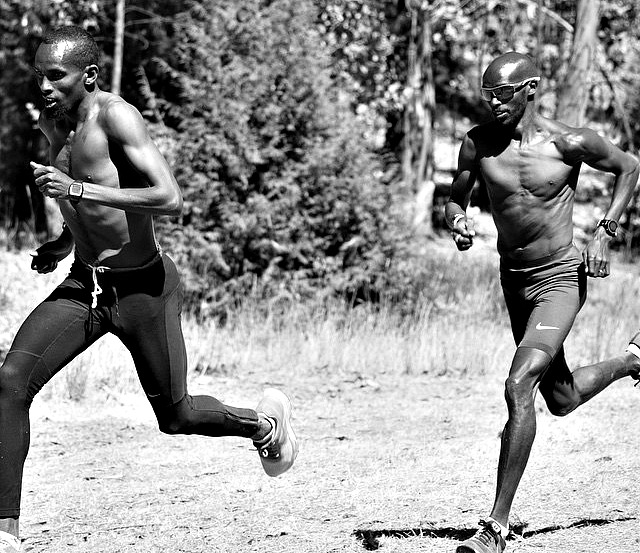I heard that to increase efficiency, you should increase your running cadence, but what I didn’t know was that landing with a forefoot strike actually leads to a higher step rate.
Intentionally moving your legs more rapidly in efforts to increase running cadence is not a prerequisite for efficient forefoot running.
In general, a running style with higher cadence (forefoot striking) is associated with better running economy and less injury than a running style with lower cadence (heel striking). Why? Because high cadence means less ground contact time and less ground contact time means less time for the braking force to decelerate the moving body during running.

Go Easy on Running Cadence When Forefoot Running
When we think of ways to increase cadence, the first thing that comes to mind is moving the legs more rapidly. However, observations on leg swing mechanics of East African runners, who mostly forefoot strike, hints that foot strike mediates cadence. For instance, forefoot running harbors higher cadence, therefore deliberately increasing cadence by rushing your foot to the ground has diminutive effects on performance.
Relax. Let Forefoot Running Increase Cadence For You
Most East African runners are forefoot strikers and have higher cadence than heel strike runners, but not because they intentionally move their legs more rapidly. Their legs are relaxed, which means that leg actions, like cadence, aren’t being forced.
How to relax the legs to facilitate higher cadence in forefoot running?
Increasing knee flexion and ankle plantarflexion at touchdown in forefoot running reduces moment of inertia of the leg and hip, which reduces muscular work and allows the muscles to relax.
- Heise and Martin (2008) found that these biomechanical parameters help relax the legs, but also enables the foot to be passively and quickly removed from the ground thereby ground contact time is reduced. This provides a satisfying explanation for how East African runners maintain high cadence while their legs are relaxed.
Therefore, cadence is dependent, not independent of foot strike. If you heel strike, the joint mechanics of the lower leg facilitates lower cadence, whereas if you forefoot strike, the joint mechanics of the lower leg facilitates higher cadence.
To increase cadence, don’t aggressively swing your legs faster, just focus on bending your knees, relaxing your ankles and land properly on your forefoot. With proper biomechanics in place, forefoot running will naturally guide your cadence rate –boosting it yourself will be counterintuitive.
More From Run Forefoot:
- Tips for Joggers with ACL Reconstructed Knees
- Running with Medial Shin Pain
- Reduce Knee Joint Loads with Forefoot Running
- Running Shoes for Forefoot Running
- High or Low Arches Not a Problem for Forefoot Running
References:
Arampatzis, A., Brüggemann, G.P. and Metzler, V. (1999) The effect of speed on leg stiffness and joint kinetics in human running. Journal of Biomechanics 32(12), 1349-1353.
Heise, G.D. and Martin, P.E. (1998) “Leg spring” characteristics and the aerobic demand of running. Medicine and Science in Sports and Exercise 30(5), 750-754.
Larsen, H.B., Christensen, D.L., Nolan, T. and Søndergaard, H. (2004) Body dimensions, exercise capacity and physical activity level of adolescent Nandi boys in western Kenya. Annals of Human Biology 31(2), 159-174.
Bretta Riches
BSc Neurobiology; MSc Biomechanics candidate, ultra minimalist runner & founder of RunForefoot. I was a heel striker, always injured. I was inspired by the great Tirunesh Dibaba to try forefoot running. Now, I'm injury free. This is why I launched Run Forefoot, to advocate the health & performance benefits of forefoot running and to raise awareness on the dangers of heel striking, because the world needs to know.
Latest posts by Bretta Riches (see all)
- Can You Run In Barefoot Shoes? Yes, But DON’T Heel Strike! - 21/07/2024
- Why Cushioned Running Shoes Are Really Bad for Your Feet - 19/07/2024
- Do Cushioned Running Shoes Cause Injuries? - 17/07/2024

Leave a Reply